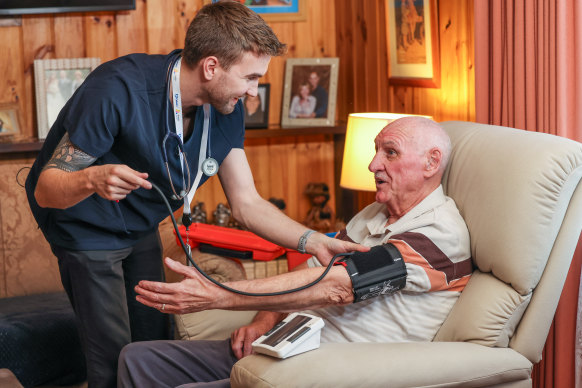- Exclusive
- National
- Healthcare
This was published 7 months ago
Australia could save $7 billion by turning homes into hospitals
Hundreds of thousands of seriously ill patients could be safely treated in their homes, freeing up critically needed hospital beds, if Australia committed to a major expansion of virtual hospitals.
A new KPMG report, commissioned by Medibank, found home hospitals (also known as virtual hospitals or “hospital in the home”) can treat up to 30 per cent of diagnoses treated in traditional hospitals – including cardiac failure, pneumonia, blood clots, severe mastitis, cellulitis and infections requiring intravenous antibiotics – as well as provide effective post-operative care.

My Home Hospital nurse Elijah Shevchenko checks on pneumonia patient Leonard Nicholls.
If Australia started expanding home hospitals now, up to 350,000 people who would otherwise be in a hospital bed could be treated at home in 2030, saving up to $1 billion in healthcare costs and more than $6 billion in capital expenditure, according to the report, released on Wednesday.
Medibank CEO David Koczkar said home hospitals were critical to relieving significant challenges in public hospitals, including ambulance ramping, bed block and chronic health workforce shortages.
“We know patients want the option to be treated in the comfort of their own home, and it frees up precious beds for those that really need it,” Koczkar said.
“To have hospital-level care in the comfort of your own home surrounded by loved ones could make a huge difference for patients and the sustainability of healthcare systems.”
Home hospitals replicate the care provided in brick-and-mortar hospitals, blending telehealth with face-to-face care by doctors, nurses and allied health practitioners.
Elements of home hospitals might include mobile X-ray and ultrasound machines, IV antibiotics, blood tests, medication and remote monitoring of pulse, temperature and blood pressure.
When Leonard Nicholls’ doctor advised he continue his pneumonia treatment at home, he thought it was a marvellous idea.
It had been two days since an ambulance brought the 74-year-old to Lyell McEwin Hospital in Adelaide with severe chest pains. “Once I was feeling much more comfortable, and I’d had all my tests, we discussed my care plan and I was ready to get back home,” Nicholls said.
Nicholls was admitted to My Home Hospital, a joint venture between Medibank’s Amplar Health, Calvary Health and South Australia’s health department. Since 2021, the hospital has treated more than 17,000 public patients.
The program has freed up more than 69,000 hospital “bed days” and has a patient satisfaction rate of 98 per cent, according to Medibank’s report.
Nurses visited Nicholls thrice a day and he contacted his doctor through phone and video calls on an iPad provided by the service.
Meanwhile, he could sleep in his bed, use his bathroom, eat his food and be with his wife, Barbara, and Chloe, their french bulldog-cross-staffie.
“[Barbara] would have really struggled without me ... so it was superb that I could be home with her,” he said.
The report suggested Australia was a slow adopter of home hospitals, instead building new – and expanding existing – public hospitals to treat a growing ageing population with chronic and complex health conditions.
Consulting economist to KPMG Dr Craig Emerson said major expansion of home hospitals could save $6.4 billion in capital expenditure by 2030.
“The old model would say ‘we need another bed for every extra patient who needs hospital care’. Why not use the asset of a person’s home?” Emerson said.
Federal Health Minister Mark Butler said he would monitor My Home Hospital to see how the model might be adopted more broadly.
“Across the country, hospitals are under pressure,” Butler said. “That’s why states are looking at innovative partnerships to relieve pressures on public hospitals.”
A recent Cochrane review – the gold standard in systematic reviews of medical research – found home hospitals were comparable to traditional hospitals in clinical outcomes and reduced length of initial hospital stays.
A separate Cochrane review found that for a major expansion of home hospitals to be effective, health service managers, health professionals and policymakers needed more evidence about implementing and sustaining them.
NSW Health Minister Ryan Park has announced $31.4 million to expand his state’s home hospital program to free up almost 9000 bed-days annually in hospitals including Liverpool and Campbelltown.
The Australian Medical Association’s (AMA) Clear The Hospital Logjam campaign called for technological innovations including expanding home hospitals.
AMA president Dr Danielle McMullen said any expansion must coordinate with current services and ensure virtual care does not replace “boots on the ground”, particularly in rural areas.
“Hospitals are needed when you’ve got an urgent, life-threatening problem … and need round-the-clock care, but there are many people in hospital beds who have had their initial treatment and the rest of their care could be done at home,” McMullen said.
Start the day with a summary of the day’s most important and interesting stories, analysis and insights. Sign up for our Morning Edition newsletter.